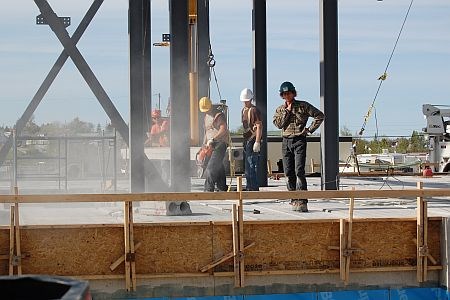Nearly $20 million in infrastructure projects are scheduled or underway in the City of Timmins.
"Timmins has been pretty sheltered economically thanks to gold, and we have to make sure that we can keep meeting the needs of people who want to build here," says Mark Jensen, the city's director of development services.
"There are some challenges throughout the city on that, and we're trying to meet those challenges as best we can."
One such challenge has long been seen in the city's west end, where maximized capacity resulted in a moratorium on further development. With the installation of $4.8 million in additional sewage lines, however, up to 30 acres of space for new development will be freed up, in a general area west of McBride Street, behind the Porcupine Mall.
The move will allow future development along available stretches of land on Riverside Drive, a location highly popular with retail firms due to its proximity to malls and the entrance to the city.
Roughly $3 million is also being spent on a new pumping station on the corner of Moneta Avenue and Vipond Road. This will increase waterflow and pressure through to the communities of Schumacher, Porcupine and South Porcupine in anticipation of further growth.
Other projects include nearly $1 million to extend a waterline through to the Winding Woods subdivision, behind the Timmins and District Hospital on Michelano Drive and Texas Gulf Road. This work is already largely complete, with water testing and approvals pending from the province.
Growing developer interest in the north end of the city is encouraging similar examination of water and sewer capacity in the area, with investigation into the matter due to begin in the coming months.
Roadwork will require $8 million through 2009, while stimulus funding and other infrastructure-focused initiatives have also allowed the city to pursue the $5.6-million replacement of the Barber's Bay bridge.
These and other city-led capital projects would have eventually happened over time, but the availability of funding from provincial and federal levels of government represent a "convergence of opportunity," says Fred Gibbons, vice-president of the Timmins Chamber of Commerce.
Still, he cautions the chamber will continue to carefully monitor the city's spending to ensure construction money is being used on items representing long-term sustainability rather than low-priority, high-maintenance projects.
Having once served as a financial consultant with the province, he also warns that infrastructure investment can become a potential burden on taxpayers if invested unwisely.
"I used to caution municipalities that getting the money, the capital, is easy; that's what guys like me were there for," says Gibbons, who also serves as acting president of Northern College. "When the projects get built, guys like me aren't there any longer, and the operating costs are now yours to bear."
Infrastructure Ontario funding is also being used by the city to invest in the construction of the $9-million Cochrane District Social Services Administration Board on Algonquin Boulevard. When complete, the facility will centralize four offices scattered throughout the community.
This will create additional spaces downtown, an area where infill development was already being encouraged.
In a continuing effort to help fill these gaps and promote downtown development, the city has approved a five-year tax increment program (TIP) for the area.
Under the program, renovations and new construction projects over $500,000 would see the municipal tax completely waived in the first year, with 25 per cent drops each year until the five-year mark, at which point the tax will be fully collected.
As an example, a $12-million hotel development would require $418,000 in municipal property tax. In the first year, it would be fully exempt, whereas in the second year it would be 75 per cent exempt, requiring payment of $104,500. This scale would continue through to year five, at which point the full $418,000 would be required annually, though not without having saved the owners $1,045,000 in waived property taxes.
The move would reduce city income in the short-term, though the move will likely encourage enough development downtown to allow for "notable" tax collection through the long-term, says Jensen.
www.timmins.ca
www.timminschamber.on.ca




